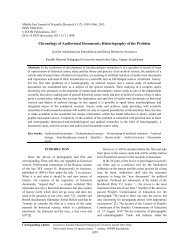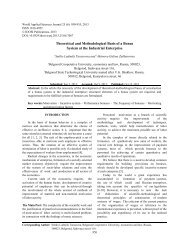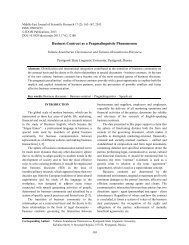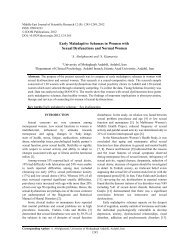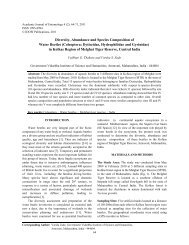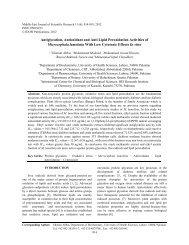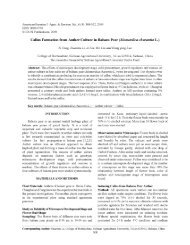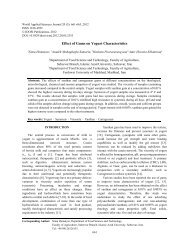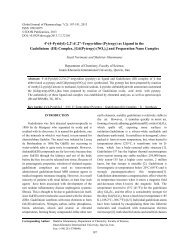Knowledge, Attitude and Behavior (Practice) Toward Sunscreen Use ...
Knowledge, Attitude and Behavior (Practice) Toward Sunscreen Use ...
Knowledge, Attitude and Behavior (Practice) Toward Sunscreen Use ...
You also want an ePaper? Increase the reach of your titles
YUMPU automatically turns print PDFs into web optimized ePapers that Google loves.
World Applied Sciences Journal 22 (5): 683-689, 2013<br />
ISSN 1818-4952<br />
© IDOSI Publications, 2013<br />
DOI: 10.5829/idosi.wasj.2013.22.05.102<br />
<strong>Knowledge</strong>, <strong>Attitude</strong> <strong>and</strong> <strong>Behavior</strong> (<strong>Practice</strong>) <strong>Toward</strong> <strong>Sunscreen</strong> <strong>Use</strong><br />
among Hospital Personnel in Comparison with Laypeople in Zanjan, Iran<br />
1 2 3<br />
M.D. Afshar Ramezanpour, Ali Niksirat <strong>and</strong> Shiva Golshahi Rad<br />
1<br />
Department of Dermatology, Valiasr Hospital, School of Medicine,<br />
Zanjan University of Medical Sciences, Zanjan, Iran<br />
2<br />
School of Medicine, Zanjan University of Medical Sciences, Zanjan, Iran<br />
3<br />
General practitioner, Educational Develop Center, Zanjan University of Medical Sciences, Zanjan, Iran<br />
Abstract: <strong>Sunscreen</strong> use has the potential to block <strong>and</strong>/or absorb ultraviolet radiation from the sun, decreasing<br />
the risk of skin cancer <strong>and</strong> delaying the photo-aging process. The objective of this cross-sectional study was<br />
to determine the knowledge, attitude <strong>and</strong> practice of academic hospital personnel. 518 persons (259 personnel<br />
<strong>and</strong> last year medical <strong>and</strong> nursing students of Valiasr <strong>and</strong> Mosavi University Hospitals <strong>and</strong> 259 age-matched<br />
patients) were recruited to the study. A total of 31 question items (5 demographics, 11 knowledge, 11 attitude<br />
<strong>and</strong> 4 sunscreen use behaviors) were included. The cases had a mean score of 7.17 (2.18), while the mean score<br />
of the control group was 5.60 (2.57) for sunscreen use knowledge (t=-7.006, p
World Appl. Sci. J., 22 (5): 683-689, 2013<br />
Table 1:<br />
Frequency of different occupational groups among hospital<br />
personnel (N=259)<br />
Sex (%)<br />
-----------------------------------------------------------------<br />
Occupation Female Male Total (%)<br />
Physician 19 (7.8) 2 (13.3) 21(8.1)<br />
Nurse 134 (54.9) 5 (33.3) 139 (53.7)<br />
Midwife 15 (6.1) 0 (0.0) 15 (5.8)<br />
Student 35 (14.3) 5 (33.3) 40 (15.4)<br />
Lab technician 16 (6.6) 1 (6.7) 17 (6.6)<br />
Nursing assistant 25 (10.2) 2 (13.3) 27 (10.4)<br />
259 age-matched patients were visiting the hospital<br />
ambulatory clinics, as the control group in spring 2011.<br />
Mean age of participants was 28.68 (6.05) years old. Other<br />
demographics are shown in table 2. Dermatology members<br />
of staff were excluded from the case group <strong>and</strong> patients<br />
that were involved in health care professions or had a<br />
higher education in medical sciences were excluded from<br />
the control group. Structured questionnaires were<br />
administered to the subjects. Face-to-face interviews were<br />
conducted for illiterate respondents in the control group.<br />
Interviews were performed by previously trained nursing<br />
assistant staff from the same hospital. When a responder<br />
refused to participate, the next one was asked <strong>and</strong> so<br />
forth. Refusal rate to participate was very low.<br />
The questionnaire was about sunscreen use<br />
knowledge, attitudes <strong>and</strong> behaviors. A total of 31<br />
question items were included, among which 5 were<br />
demographics, 11 were about sunscreen use knowledge,<br />
11were about attitude toward sunscreen use <strong>and</strong> 4 were<br />
sunscreen use behaviors. The knowledge questions were<br />
in a multiple choice format, with one correct answer for<br />
each question, while the attitude scale consisted of fivepoint<br />
Likert type items. The questionnaire's content<br />
validity was assured after consulting with a dermatologist.<br />
<strong>Knowledge</strong> was evaluated using the total scores for<br />
each subject on knowledge questions, with one point for<br />
each correct answer <strong>and</strong> zero points for each incorrect<br />
answer, to a maximum of 11 potential points if<br />
one answered all knowledge questions correctly.<br />
Of these 11 multiple choice questions, 3 questioned the<br />
meaning of SPF (sun protection factor), side effects of<br />
sunscreen use (skin inflammation <strong>and</strong> allergy in high<br />
doses <strong>and</strong> skin ageing when used constantly) <strong>and</strong> types<br />
of sunscreen (organic <strong>and</strong> inorganic) <strong>and</strong> 8 questioned<br />
the short-term (sunburn, erythema <strong>and</strong> irritation) <strong>and</strong><br />
long-term (lentigo, skin cancer, wrinkles, telangiecasia <strong>and</strong><br />
fragility) harms of sunlight on skin.<br />
<strong>Attitude</strong> toward sunscreen use was measured by<br />
summing obtained scores on attitude items for each<br />
subject. After the adjustments made for attitudinal<br />
question items in terms of coding direction, each item was<br />
scored five points for the most positive (favorable to<br />
sunscreen) <strong>and</strong> one point for the most negative (against<br />
sunscreen) attitude. With a total of 11 attitudinal question<br />
items, the possible total attitude score for each subject<br />
ranged from 11 to 55. These attitudinal question items<br />
were in three categories (economic, physical <strong>and</strong><br />
emotional) ranging from totally agree to totally disagree.<br />
The economic aspect of attitude consisted of two items<br />
including: "Using sunscreen is an extra cost"; <strong>and</strong><br />
"Buying sunscreen is only beneficiary for cosmetic<br />
industries". The physical aspect of attitude consisted of<br />
two items including: "I dislike the sunscreen's odor"; <strong>and</strong><br />
"I feel heaviness on my skin when using sunscreen". The<br />
emotional aspect of attitude consisted of seven items<br />
including: "I believe that no sunscreen is compatible with<br />
my skin"; "Using sunscreen has side effects on skin"; "<br />
Using sunscreen is an obstacle for cosmetic use";<br />
"<strong>Sunscreen</strong>'s efficiency has not been proved by medical<br />
studies"; "<strong>Sunscreen</strong> benefits are more than its<br />
disadvantages"; "<strong>Sunscreen</strong> decreases skin stains"; <strong>and</strong><br />
" I have a better feeling when using sunscreen".<br />
Self-care practices or behaviors were assessed<br />
through four question items. The first, asking "Do you<br />
use sunscreen in your daily life?", as a yes/no question,<br />
assessed the respondents practice toward sunscreen. The<br />
next two were multiple response items measured on a fivepoint<br />
scale, with response options ranging from very<br />
much to very little. The items were: "How much sunscreen<br />
do you use?" <strong>and</strong> "Is SPF effective on choosing your<br />
Table 2: Frequency of sex <strong>and</strong> educational degree among responders<br />
Demographic feature Case (%) Control (%) P value<br />
Sex (N=518) Female 244 (94.2) 204 (78.8)
World Appl. Sci. J., 22 (5): 683-689, 2013<br />
sunscreen?" The distribution on the variables was<br />
skewed so they were dichotomized. The items were<br />
collapsed into "very much or much" <strong>and</strong> "so-so, little or<br />
very little". The last question item, asking "Which type of<br />
sunscreen do you use?" with three answers including<br />
"Organic", "Non-organic" or "Doesn't matter", assessed<br />
the respondents' tendency toward different types of<br />
sunscreen.<br />
The following items were included as demographic<br />
indicators: gender, age, level of education, field of higher<br />
education <strong>and</strong> occupation. Level of education was<br />
categorized as without higher education (i.e. college <strong>and</strong><br />
below college), BA (Bachelor of Art) <strong>and</strong> MS/MD (Master<br />
of Science/ Medical Doctorate).<br />
In a pilot study the reliability of knowledge<br />
<strong>and</strong> validity assessing questions was tested <strong>and</strong> a<br />
Cronbach's alpha of 0.717 <strong>and</strong> 0.86 were obtained<br />
respectively.<br />
Data were presented as frequency (%) or mean<br />
2<br />
(SD=st<strong>and</strong>ard deviation). Pearson chi analysis was used<br />
to assess associations between categorical values <strong>and</strong> the<br />
groups. When the sample was small, the Fisher exact test<br />
was used. T-test <strong>and</strong> one-way analysis of variances were<br />
used when comparing continuous variables (e.g.<br />
knowledge <strong>and</strong> attitude scores) between two groups <strong>and</strong><br />
more than two groups, respectively. General linear model<br />
(GLM) univariate analysis was used to evaluate the<br />
interaction between two categorical values on the mean of<br />
a continuous variable. Linear <strong>and</strong> logistic regression<br />
analysis were performed to explore the predictive value of<br />
different independent variables on continuous<br />
(knowledge <strong>and</strong> attitude) <strong>and</strong> categorical (behavior)<br />
dependent variables, respectively. Missing values were<br />
omitted in every statistical test. A P value of
World Appl. Sci. J., 22 (5): 683-689, 2013<br />
Table 4: Question items assessing attitude of subjects toward sunscreen use<br />
Case<br />
Control<br />
Question item Mean (SD) Mean (SD) P value<br />
*<br />
Economic 7.84 (1.59) 7.80 (1.49) 0.782<br />
It's an extra cost 4.01 (0.84) 4.00 (0.83) 0.915<br />
It's only beneficiary for cosmetic industry 3.82 (0.93) 3.80 (0.90) 0.795<br />
*<br />
Physical 7.21 (1.68) 7.32 (1.77) 0.474<br />
I dislike its odor 3.77 (0.98) 3.83 (0.88) 0.465<br />
I feel heaviness on my skin 3.43 (1.10) 3.46 (1.11) 0.755<br />
**<br />
Emotional 27.21 (4.41) 26.32 (4.11) 0.027<br />
No sunscreen is compatible with my skin 3.84 (0.94) 3.66 (1.01) 0.039<br />
It has its own side effects 3.55 (0.96) 3.47 (1.00) 0.367<br />
It's an obstacle for cosmetic use 3.95 (0.89) 3.84 (0.94) 0.190<br />
Its efficiency has not been proved by medical studies 3.94 (0.87) 3.82 (0.90) 0.137<br />
Its benefit is more than its harm 4.07 (0.87) 3.78 (1.03) 0.001<br />
It decreases skin stains 4.02 (0.87) 3.76 (0.99) 0.002<br />
I have a better feeling when using it 3.88 (0.91) 3.81 (0.95) 0.400<br />
*Maximum score of the category is 10 <strong>and</strong> maximum score of each of the question items in the category is 5.<br />
**Maximum score of the category is 35 <strong>and</strong> maximum score of each of the question items in the category is 5.<br />
Table 5: Comparison of knowledge <strong>and</strong> attitude toward sunscreen use within different groups of hospital personnel<br />
Physician Nurse Student Midwife Lab technician Nursing assistant P value<br />
<strong>Knowledge</strong> Mean (SD) 8.7 (1.12) 7.34 (2.00) 7.87 (1.72) 7 (1.35) 5.35 (1.96) 4.68 (2.92)
World Appl. Sci. J., 22 (5): 683-689, 2013<br />
Comparison of the knowledge <strong>and</strong> attitude between achieve 10–15-fold protection, a sunscreen rated<br />
different groups of hospital personnel showed a SPF30–SPF50 needs to be applied [18]. In our survey,<br />
significant difference (Table 5). Post hoc test revealed this considering the amount of the sunscreen being used, only<br />
difference in knowledge as a significant difference in a small proportion of the consumers (42.3% of the hospital<br />
scores of nursing assistants with physicians (p
World Appl. Sci. J., 22 (5): 683-689, 2013<br />
finding that is in accordance with the general trend in the<br />
literature [12, 24, 25]. There was no interaction between<br />
sex <strong>and</strong> the groups regarding knowledge <strong>and</strong> attitude,<br />
using general linear model analysis, which means that<br />
being involved in a health care professional does not<br />
affect this difference between sexes' knowledge <strong>and</strong><br />
attitude toward sunscreen use.<br />
Women seemed to be more vigilant in protecting<br />
themselves from sunburn. They displayed more favorable<br />
behaviors than men, such as the more frequent use of<br />
sunscreen, preferable amount of sunscreen use <strong>and</strong> taking<br />
into account SPF in their sunscreen selection. This is<br />
consistent with other findings in the literature [24, 26, 27,<br />
28, 29]. Nevertheless, some studies showed that men<br />
respondents were more likely to use other kinds of sunprotection<br />
(e.g. wearing a cap) rather than using<br />
sunscreen, explaining the lower rate of sunscreen use by<br />
men [30-33].<br />
Higher level of education was associated with a<br />
better knowledge, attitude <strong>and</strong> behavior toward sunscreen<br />
use, as shown in the regression model. The subgroup<br />
among the health care professions that had a lower<br />
knowledge <strong>and</strong> attitude (nursing assistants) had also a<br />
lower education level (without higher education). When<br />
excluded, positive behavior in health care professions<br />
toward sunscreen use became significantly higher than<br />
that of the ones in the control group. It can be assumed<br />
that a higher level of knowledge in higher level of<br />
educations can lead to a better attitude <strong>and</strong> behavior. This<br />
is in line with other previous studies [29, 34, 35].<br />
As a limitation to this study some other variables<br />
such as skin type, sun exposure behaviors, history of<br />
sunburns <strong>and</strong> other sun protection used were not<br />
considered which could confound the results.<br />
CONCLUSION<br />
Although there was a trend to a higher level of<br />
relevant knowledge in the health care professionals than<br />
in laypeople, there was no significant difference between<br />
the two groups regarding effective behavior toward<br />
sunscreen use, except for physicians. Despite the<br />
importance of health promotion in primary <strong>and</strong> secondary<br />
prevention, it is disappointing that health care<br />
professionals are no different from the laypeople when it<br />
comes to effective sun protection behavior. In order to<br />
improve this area of health education <strong>and</strong> promotion,<br />
health care professionals especially nurses <strong>and</strong> nursing<br />
assistants should be targeted in education campaigns<br />
regarding sun exposure <strong>and</strong> protection.<br />
REFERENCES<br />
1. Karagas, M.R., H.H. Nelson, M.S. Zens, M. Linet,<br />
T.A. Stukel, S. Spencer, K.M. Applebaum, L. Mott<br />
<strong>and</strong> K. Mabuchi, 2007. Squamous cell <strong>and</strong> basal cell<br />
carcinoma of the skin in relation to radiation therapy<br />
<strong>and</strong> potential modification of risk by sun exposure.<br />
Epidemiology, 18(6): 776-784.<br />
2. Bordeaux, J.S., K.Q. Lu <strong>and</strong> K.D. Cooper, 2007.<br />
Melanoma: prevention <strong>and</strong> early detection. Semin<br />
Oncol, 34(6): 460-466.<br />
3. MacKie, R.M., 2006. Long-term health risk to the skin<br />
of ultraviolet radiation. Prog Biophys Mol. Biol.,<br />
92(1): 92-96.<br />
4. Sivamani, R.K., L.A. Crane <strong>and</strong> R.P. Dellavalle, 2009.<br />
The benefits <strong>and</strong> risks of ultraviolet tanning <strong>and</strong> its<br />
alternatives: the role of prudent sun exposure.<br />
Dermatol Clin., 27(2): 149-154.<br />
5. Wulf, H.C., J. S<strong>and</strong>by-Moller, T. Kobayasi <strong>and</strong><br />
R. Gniadecki, 2004. Skin aging <strong>and</strong> natural<br />
photoprotection. Micron, 35(3): 185-191.<br />
6. Weinstock, M.A., 2001. <strong>Sunscreen</strong> use can reduce<br />
melanoma risk. Photodermatol. Photoimmunol.<br />
Photomed, 17(5): 234-236.<br />
7. Gallagher, R.P., 2005. <strong>Sunscreen</strong>s in melanoma <strong>and</strong><br />
skin cancer prevention. CMAJ, 173(3): 244-245.<br />
8. Diffey, B.L., 2005. <strong>Sunscreen</strong>s <strong>and</strong> melanoma:<br />
the future looks bright. Br J. Dermatol.,<br />
153(2): 378-381.<br />
9. Cokkinides, V., M. Weinstock, K. Glanz, J. Albano,<br />
E. Ward <strong>and</strong> M. Thun, 2006. Trends in sunburns,<br />
sun protection practices <strong>and</strong> attitudes toward sun<br />
exposure protection <strong>and</strong> tanning among US<br />
adolescents, 1998-2004. Pediatrics, 118(3): 853-864.<br />
10. Dobbinson, S.J., M.A. Wakefield, K.M. Jamsen,<br />
N.L. Herd, M.J. Spittal, J.E. Lipscomb <strong>and</strong> D.J. Hill,<br />
2008. Weekend sun protection <strong>and</strong> sunburn in<br />
Australia trends (1987-2002) <strong>and</strong> association with<br />
SunSmart television advertising. Am. J. Prev. Med.,<br />
34(2): 94-101.<br />
11. Wright, M.W., S.T. Wright <strong>and</strong> R.F. Wagner, 2001.<br />
Mechanisms of sunscreen failure. J. Am. Acad<br />
Dermatol., 44(5): 781-784.<br />
12. Wang, S.Q. <strong>and</strong> S.W. Dusza, 2009. Assessment of<br />
sunscreen knowledge: a pilot survey. Br J. Dermatol.,<br />
161(Suppl 3): 28-32.<br />
13. Cac, N.N., H.W. Walling, C. Vest <strong>and</strong> W. Ting, 2008.<br />
Differences in perceived importance <strong>and</strong> personal use<br />
of sun protection among primary care physicians are<br />
reflected in their clinical practice. Int. J. Dermatol.,<br />
47(2): 137-143.<br />
688
World Appl. Sci. J., 22 (5): 683-689, 2013<br />
14. Hymowitz, M.B., B.B. Hayes, J.J. Maury <strong>and</strong> 26. de Vries, H., J. Lezwijn, M. Hol <strong>and</strong> C. Honing, 2005.<br />
A.C. Geller, 2006. Evaluation of medical students' Skin cancer prevention: behaviour <strong>and</strong> motives of<br />
knowledge, attitudes <strong>and</strong> personal practices of sun Dutch adolescents. Eur. J. Cancer Prev., 14(1): 39-50.<br />
protection <strong>and</strong> skin self-examination. Arch Dermatol., 27. Stanton, W.R., M. J<strong>and</strong>a, P.D. Baade <strong>and</strong><br />
142(4): 523-524. P. Anderson, 2004. Primary prevention of skin cancer:<br />
15. Johnson, K.R., L.F. Heilig, E.J. Hester, S.O. Francis, a review of sun protection in Australia <strong>and</strong><br />
S.J. Deakyne <strong>and</strong> R.P. Dellavalle, 2006. internationally. Health Promot Int., 19(3): 369-378.<br />
Indoor tanning attitudes <strong>and</strong> practices of US 28. Alberg, A.J., R.M. Herbst, J.M. Genkinger <strong>and</strong><br />
dermatologists compared with other medical K.R. Duszynski, 2002. <strong>Knowledge</strong>, attitudes <strong>and</strong><br />
specialists. Arch Dermatol., 142(4): 465-470.<br />
behaviors toward skin cancer in Maryl<strong>and</strong> youths.<br />
16. Scerri, L., S. Aquilina, G.A. Amato <strong>and</strong> M. Dalmas, Journal of Adolescent Health, 31(4): 372-377.<br />
2002. Sun awareness <strong>and</strong> sun protection practices in 29. Branstrom, R., H. Ullen <strong>and</strong> Y. Br<strong>and</strong>berg, 2004.<br />
Malta. J. Eur Acad Dermatol. Venereol., 16(1): 47-52. <strong>Attitude</strong>s, subjective norms <strong>and</strong> perception of<br />
17. Robinson, J.K., D.S. Rigel <strong>and</strong> R.A. Amonette, 1997. behavioural control as predictors of sun-related<br />
Trends in sun exposure knowledge, attitudes <strong>and</strong> behaviour in Swedish adults. Prev. Med.,<br />
behaviors: 1986 to 1996. J. Am. Acad Dermatol., 39(5): 992-999.<br />
37(2 Pt 1): 179-186. 30. Jerkegren, E., L. S<strong>and</strong>rieser, Y. Br<strong>and</strong>berg <strong>and</strong><br />
18. Diffey, B.L., 2009. <strong>Sunscreen</strong>s: expectation <strong>and</strong> I. Rosdahl, 1999. Sun-related behaviour <strong>and</strong><br />
realization. Photodermatol Photoimmunol. Photomed., melanoma awareness among Swedish university<br />
25(5): 233-236. students. Eur. J. Cancer Prev., 8(1): 27-34.<br />
19. Diffey, B.L., 2001. <strong>Sunscreen</strong>s <strong>and</strong> UVA protection: 31. Geller, A.C., K. Glanz, D. Shigaki, M.R. Isnec, T. Sun<br />
a major issue of minor importance. Photochem <strong>and</strong> J. Maddock, 2001. Impact of skin cancer<br />
Photobiol., 74(1): 61-63.<br />
prevention on outdoor aquatics staff: the Pool Cool<br />
20. Darling, M. <strong>and</strong> S.H. Ibbotson, 2002. Sun awareness program in Hawaii <strong>and</strong> Massachusetts. Prev Med.,<br />
<strong>and</strong> behaviour in healthcare professionals <strong>and</strong> the 33(3): 155-161.<br />
general public. Clin. Exp. Dermatol., 27(6): 442-444. 32. Abroms, L., C.M. Jorgensen, B.G. Southwell,<br />
21. Jones, B., C. Oh, E. Corkery, R. Hanley <strong>and</strong> A.C. Geller <strong>and</strong> K.M. Emmons, 2003.<br />
C.A. Egan, 2007. <strong>Attitude</strong>s <strong>and</strong> perceptions regarding Gender differences in young adults' beliefs about<br />
skin cancer <strong>and</strong> sun protection behaviour in an Irish sunscreen use. Health Educ Behav, 30(1): 29-43.<br />
population. J. Eur. Acad Dermatol. Venereol., 33. Schofield, P.E., J.L. Freeman, H.G. Dixon, R. Borl<strong>and</strong><br />
21(8): 1097-1101. <strong>and</strong> D.J. Hill, 2001. Trends in sun protection<br />
22. Gritz, E.R., M.K. Tripp, C.A. de Moor, S.A. Eicher, behaviour among Australian young adults. Aust N Z<br />
N.H. Mueller <strong>and</strong> J.H. Spedale, 2003. Skin cancer J. Public Health, 25(1): 62-65.<br />
prevention counseling <strong>and</strong> clinical practices of 34. Lawler, S., T. Sugiyama <strong>and</strong> N. Owen, 2007.<br />
pediatricians. Pediatr Dermatol., 20(1): 16-24.<br />
Sun exposure concern, sun protection behaviors <strong>and</strong><br />
23. Morrison, G., 1996. Sun exposure <strong>and</strong> skin cancer physical activity among Australian adults. Cancer<br />
development: nurses' attitudes. Nurs St<strong>and</strong>, Causes Control, 18(9): 1009-1014.<br />
10(36): 39-42. 35. Kristjansson, S., H. Ullen <strong>and</strong> A.R. Helgason, 2004.<br />
24. Filiz, T.M., N. Cinar, P. Topsever <strong>and</strong> F. Ucar, 2006. The importance of assessing the readiness to change<br />
Tanning youth: knowledge, behaviors <strong>and</strong> attitudes sun-protection behaviours: a population-based<br />
toward sun protection of high school students in study. Eur. J. Cancer, 40(18): 2773-2780.<br />
Sakarya, Turkey. J Adolesc Health, 38(4): 469-471.<br />
25. Robinson, J.K., A.W. Rademaker, J.A. Sylvester <strong>and</strong><br />
B. Cook, 1997. Summer sun exposure: knowledge,<br />
attitudes <strong>and</strong> behaviors of Midwest adolescents.<br />
Prev Med, 26(3): 364-372.<br />
689



